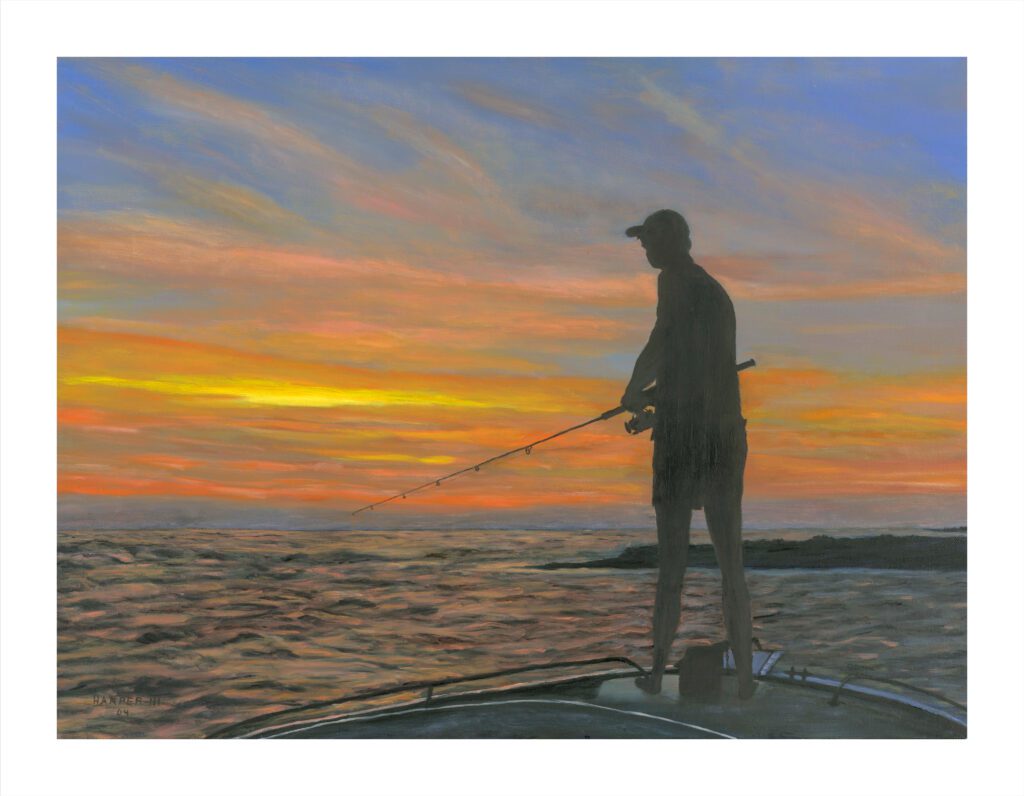How Robert Harper Captures Natural Florida
Seventy-two-year-old Robert Harper likes a challenge. In his lifetime he’s bailed hay, sold watermelons, raised beef cattle, and grown citrus. Formerly a Central Florida developer, the Lakeland Realtor is now growing peaches and painting. “It’s probably the most relaxing thing I do. I don’t get to do it as much as I like,” he says of his painting.[emember_protected custom_msg=”Click here and register now to read the rest of the article!”]
Harper didn’t take up art until he was about 60, when he came home one evening to a painting party his wife, Amy, was having with friends. They were painting on glasses and it looked like fun, so he decided to try it. “I painted some different scenes of animals on four glasses,” says Harper, who is also the broker/owner at WebPro Realty.
From there, he started painting on different glasses, and pitchers and plates, until he filled their cabinets. When Amy suggested it was time to graduate to canvas, he agreed.
Now he sells canvas prints of his artwork, and donates his work to charitable causes. His original painting, Wetland Sanctuary, represents Florida at the National Association of Home Builders Housing Center in Washington, D.C. Inducted into the Florida Home Builders Association Hall of Fame in 2004, he currently serves as chairman of the Hall of Fame Committee for the group in Tallahassee.
Harper likes to watch others and learn new things. He watched other people bail hay and sell watermelons, so he tried that. With art, it was the same. He watched some videos and read a lot of books. And he learned from other artists, among them Martin Johnson Heade of the Hudson River School Artists from 1825 to 1910. He also was inspired by Hudson River School Artists Thomas Moran, Albert Bierstadt, Thomas Cole, Frederic Church, and Jasper Cropsey.
Thomas Fagen, curator at The Studio at Gulf and Pine at Anna Maria, describes Harper’s work as primitive and realistic, in the tone of Robert Butler, one of the Florida Highwaymen who sold their work from their cars from the 1950s through 1980s. “He definitely uses bright colors,” he says of Harper’s work. “He did a collection of native sea turtles. They were just real stunning.”
The studio is owned by former Governor Lawton Chiles’ widow, Rhea, and features many different artists. “I would recommend him [Harper] to anyone. He will definitely have more shows in here,” Fagen says.
Harper’s style has also been described as natural. He uses vivid oils, depicting dramatic skies, tranquil Florida landscapes and seascapes. “He can do impressionistic stuff and he can do a sea turtle,” says Nicole Dezayas of Lakeland, a friend of Amy. “If you have an eye for art you would not think it’s primitive and would not believe he just picked this up.”
Mark Overstreet, a Lakeland rancher and businessman, likes to tease by telling him he has someone else do the art, then takes the credit. “Robert is one of the best natural painters that I’ve ever seen,” Overstreet says. “He knows how to put things in perspective.” Overstreet appreciates the time Harper puts into each painting. “He takes his time and does it right,” he adds.
Lakeland attorney Ben Hardin, Jr. has five of Harper’s paintings in one conference room at his office. “We call it the Robert Harper Conference Room,” says Hardin, who has been Harper’s attorney for more than 20 years. “I like the outdoors part of it, the creativity that he sees. It’s really neat.”
Although Harper’s early work was with acrylics, he now prefers oils, which he considers “more artist friendly.” Because it takes two to three days to start drying, he is able to come back later and make changes more easily. “I love to paint with oil,” he says. “I can blend the colors better.”
He works from photographs. “I was a hunter. In my last 10 to 15 years, I’d really rather take pictures. I hunt to take pictures,” he says.
With paintings such as Peaceful Hideaway, First Light, Mystic Sunset, Wetland Sanctuary, Low Country, Last Cast, Overstreet Ranch and Band of Brothers, he captures natural Florida. Perhaps his favorite is Abigail’s Sky, a rural landscape with a vibrant blue sky filled with clouds. He painted it with his granddaughter in his arms. She was six months old at the time and “not a happy trooper,” he recalls. “She calmed down when I was painting.”
After getting out of the citrus and beef business, Harper stays close to the land with his peach orchard. He and his son Sean are growing 25 acres of peaches. “The maintenance is intense,” he explains. “It’s a learning process.” The peach cultivars were developed at the University of Florida to enable state growers to produce a crop in March and April, when fresh peaches are scarce. “The biggest thing you have to put up with is the shelf life of the peach. It just does not last like an orange when you pick it,” he says, adding it needs to be chilled after picking to preserve it longer.
Although it’s been a challenge, he’s no stranger to them. “I think I enjoy peaches,” he continues. “I’m not sure yet. It’s the most difficult thing I’ve probably ever done.”
But he has no plans to retire. “I don’t know what retire means,” he says. “I enjoy working, I enjoy life. We don’t come through but one time. I don’t feel like sitting down and watching TV.”
CREDITS
story by CHERYL ROGERS
[/emember_protected]

